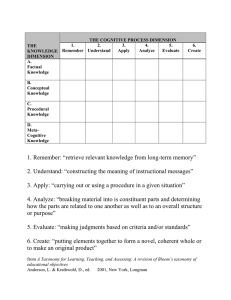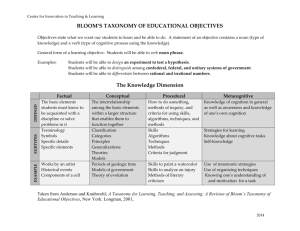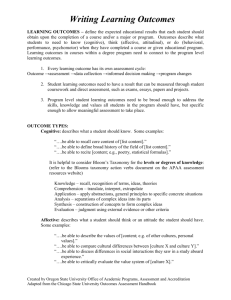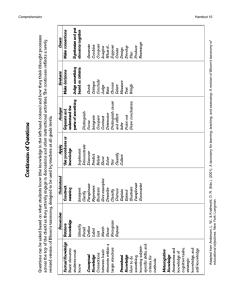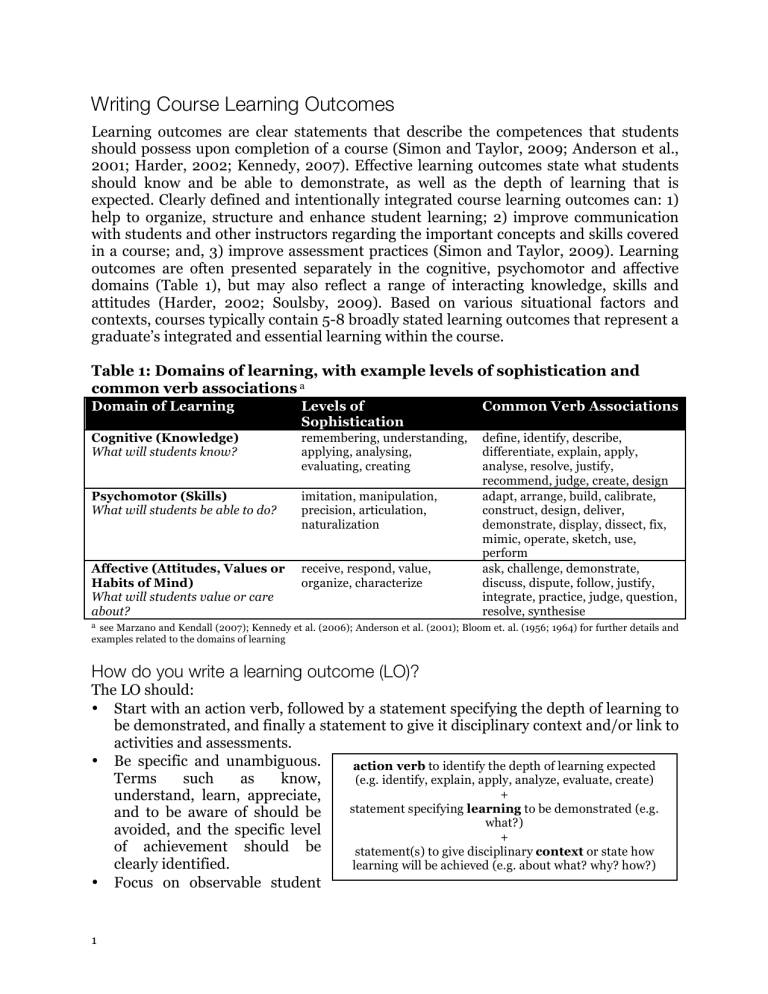
Writing Course Learning Outcomes Learning outcomes are clear statements that describe the competences that students should possess upon completion of a course (Simon and Taylor, 2009; Anderson et al., 2001; Harder, 2002; Kennedy, 2007). Effective learning outcomes state what students should know and be able to demonstrate, as well as the depth of learning that is expected. Clearly defined and intentionally integrated course learning outcomes can: 1) help to organize, structure and enhance student learning; 2) improve communication with students and other instructors regarding the important concepts and skills covered in a course; and, 3) improve assessment practices (Simon and Taylor, 2009). Learning outcomes are often presented separately in the cognitive, psychomotor and affective domains (Table 1), but may also reflect a range of interacting knowledge, skills and attitudes (Harder, 2002; Soulsby, 2009). Based on various situational factors and contexts, courses typically contain 5-8 broadly stated learning outcomes that represent a graduate’s integrated and essential learning within the course. Table 1: Domains of learning, with example levels of sophistication and common verb associations a Domain of Learning Levels of Sophistication Common Verb Associations Cognitive (Knowledge) What will students know? remembering, understanding, applying, analysing, evaluating, creating Psychomotor (Skills) What will students be able to do? imitation, manipulation, precision, articulation, naturalization Affective (Attitudes, Values or Habits of Mind) What will students value or care about? receive, respond, value, organize, characterize define, identify, describe, differentiate, explain, apply, analyse, resolve, justify, recommend, judge, create, design adapt, arrange, build, calibrate, construct, design, deliver, demonstrate, display, dissect, fix, mimic, operate, sketch, use, perform ask, challenge, demonstrate, discuss, dispute, follow, justify, integrate, practice, judge, question, resolve, synthesise a see Marzano and Kendall (2007); Kennedy et al. (2006); Anderson et al. (2001); Bloom et. al. (1956; 1964) for further details and examples related to the domains of learning How do you write a learning outcome (LO)? The LO should: • Start with an action verb, followed by a statement specifying the depth of learning to be demonstrated, and finally a statement to give it disciplinary context and/or link to activities and assessments. • Be specific and unambiguous. action verb to identify the depth of learning expected Terms such as know, (e.g. identify, explain, apply, analyze, evaluate, create) + understand, learn, appreciate, statement specifying learning to be demonstrated (e.g. and to be aware of should be what?) avoided, and the specific level + of achievement should be statement(s) to give disciplinary context or state how clearly identified. learning will be achieved (e.g. about what? why? how?) • Focus on observable student 1 • • • performance, and be capable of being assessed. It is often helpful to add the preposition “by” or “through” followed by a statement which clearly states how the LO will be assessed. Be balanced. Broad LOs are difficult to assess, while an extensive list of learning outcomes will limit flexibility and adaptability in the curriculum, and make it difficult for students and the instructor to communicate an integrated understanding of the subject matter. Be concise and clearly stated. Be achievable given the time and resources available to both learners and instructors. See Kennedy (2007) and Soulsby (2009) for additional details and examples related to writing effective course learning outcomes. Table 2: Before and after examples of course learning outcomes Before: broad and ambiguous After: direct, measurable and achievable By the end of the semester, successful students will be able to: Students will become familiar with plant and animal species in Southern Ontario • Level of achievement/sophistication expected unclear Identify and describe 15 common plant and animal species found in the Carolinian Forest Region through field study and the development of an identification guide Students will critique works of art • Additional detail required Critique contemporary works of art based on an appropriate set of criteria through studio critiques and an independent essay Students will be taught various decision-making models • Teacher-centred, level of sophistication expected unclear Apply appropriate decision-making models in business and marketing through participation in a collaborative group project Students will appreciate the ethical responsibilities of social scientists • Too broad, unclear how this can be measured Assess the ethical implications of research in the social sciences through in-class discussion and an independent written report Students will learn about research proposals • Ambiguous, level of sophistication expected unclear Develop and present a research proposal (including appropriate research methods and a review of literature) on a relevant topic in primary or secondary education, through an independent presentation and written report 2 References Anderson, L.W., Krathwohl, D.R., Airasian, P.W., Cruikshank, K.A., Mayer, R.E., Pintrich, P.R., Raths, J., and Wittrock, M.C. 2001. A Taxonomy for Learning, Teaching and Assessing: A Revision of Bloom’s Taxonomy of Educational Objectives. Longman, New York. Bloom, B.S., Engelhart, M.D., Furst, E.J., Hill, W. And Drathwohl, D. 1956. Taxonomy of Educational Objectives. Volume 1: The Cognitive Domain. MacKay, New York. Bloom, B.S., Masia, B.B. and Krathwohl, D.R. 1964. Taxonomy of Educational Objectives. Volume II: The affective domain. MacKay, New York. Harden, R.M. 2002. Learning outcomes and instructional objectives: is there a difference? Medical Teacher, 24(2), 151-155. Kennedy, D. 2007. Writing and Using Learning Outcomes: a Practical Guide. University College Cork, Ireland. Marzano, R.J. and Kendall, J.S. 2007. The New Taxonomy of Educational Objectives. Corwin Press, CA. Simon, B. and Taylor, J. 2009). What is the value of course-specific learning goals? Journal of College Science Teaching, Nov/Dec, 53-57. Soulsby, E. 2009. How to write program objectives/outcomes. Accessed online at: http://www.assessment.uconn.edu/, Feb. 9, 2011. Writing Course Learning Outcomes by Natasha Kenny, copyright 2013 Open Learning and Educational Support, University of Guelph is made available under the terms of the Creative Commons Attribution-NonCommercial-ShareAlike 4.0 International License, http://creativecommons.org/licenses/by-nc-sa/4.0/ 3
